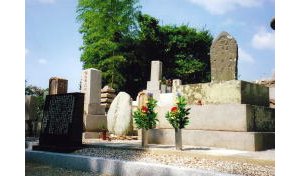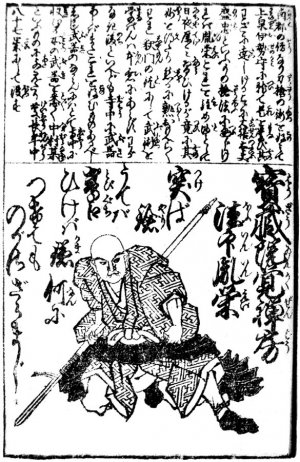Written by Kagita Chūbee, 20th sōke of the Hōzōinryū
Hōzōin Kakuzenbō Hōin Inei
Inei, the founder of the Hōzōinryū Sōjutsus, was born in the first year of Daiei (1521) as the second son of Nakamikado Tajima Inei who was a warrior monk of the Kōfukuji1. The Nakamikados were descendants of Prince Toneri2, who had been the fourth son of Emperor Tenmu3, and originally went by the family name Sakaguchi. Their ancestor Sakaguchi Musashi Nobutane had been a very strong and brave man. He loved the martial arts and was feared by everbody as the wild Musashi. In the battle of Kasagi castle in the first year of Genkō (1331), which took place during the Genkō4 war in which he fought on the emperor's side, he distingished himself and was rewarded with a sword and the family name Nakamikado by Emperor Go-Daigo5.
Later Tanesada, who was the sixth generation of Nakamikado, resided in Kaseyama castle in Kizu. He took a woman of the house of Mitsuda Saemonjō Hideyuki, who was lord of the castle on the mountain Shōyama in the Okada district in Jōshu6 as his wife. In this way the close relationship to the house of Mitsuda, which should play an important part in the succsession in the Hōzōinryū later on, was established. The Fruit of this marriage was the seventh generation, Tanenaga. Tanenaga owned a residence in Kusakojichō in Nara. He put his second child, Inei, in the tempel Hōzōin, the headmaster of which he then became.
Inei was a Monk in Nara, who loved the arts of the Sword and the Spear. The former he learned from Kamiizumi Ise no Kami until he became a master himself. Then he encountered Daizendayū Moritada's art to fight with a spear. Inei became his disciple and exercised day and night until he finally mastered the art. Later, after a lot of contemplating, he came to the decision that he did not want the monks of his temple to learn the martial arts. To prevent the possibility that someone again would take delight in the martial arts after his death only because there were weapons, Inei handed over all the weapons which were in the temple to a certain Nakamura. He died during the years of Keichō at the age of 87.
Bottom:
Hōzōin Kakuzenbō Hōin Inei
Thrusting it is a spear
Hewing it is a fire hook
Drawing it is a sickle
Anyway
It is impossible to elude this weapon
(A variation of the famous poem)
(From the Bugei Hyakunin Isshu (100 poems by/about 100 martial artists); midst 19th century.)
We can assume that Inei through constant training from early childhood on was skilled in the use of the traditional polearms of the warrior monks such as Naginata or Nagamaki. Then Narita Daizendayū Moritada appered, a martial artist who was wandering the country. He also was called ōnishi Kishunken, was a monk in the service of the Kasuga shrine and a master of the Shintōryū. Die Shintōryū was7 a complex martial art system, the curriculum of which included sword, Naginata and spear amongst others. But Moritada had specialized in the use of the Naginata the spear. This opened Inei's eyes, let him recognize the special qualities of the Jūmonjiyari and find his own style. Legend has it that at dawn of the 12th day of the first month of 22nd year of Tenbun (1553) the 33 year old Inei was initiated to two secret techinques by Narita Daizendayū Moritada who was thought of as the incarnation of Marishiten8.
Then in the sixth year of Eiroku (1563) Kamiizumi Ise no Kami Nobutsuna, the founder of the Shinkageryū, came visiting Nara and Inei together with his close friend Yagyū Muneyoshi became his disciples. When Nobutsuna visited Yagyū again in the 8th year of Eiroku they won't let him go but took his instrucions until Muneyoshi finally got the full license to teach and Inei was allowed to teach the techiniques up to the 9th level.
In my opinion the Sōjutsu of the Hōzōinryū is based on the teachings of the Shintōryū and the Shinkageryū. The development of the Sōjutsu of Hōzōinryū was very successful, until in the 13th year of Tenshō (1585) Hashiba Hidenaga9 became lord of Kōriyama castle and ordered the temples and Shintō-shrines as well as the ordinary people of the province of Yamato and the sub-temple of the Hieizan10 on the mountain Tō-no-Mine11 to surrender all weapons. The pressure thus applied towards the temples led to an abandonment of martial arts training in those places.
In the first year of Keichō (1596) the title of Hōin12 was bestowed on the 75 year old Inei. At this this time Konparu Dayū Yasuteru13 him with the request to instruct his son Shichirō Ujikatsu. Because this request was made by the house of the Nō-actors Konparu whoses influence even streched as far as Tokugawa Ieyasu14, at the age of 75 Inei took to the tried and true spear again and revived the Sōjutsu training. From then on the number of his disciples increased in a way that people said "the number of those training in this art not only fills a platoon but fills a whole army".
 On the 19th day of the fourth month of the 11th year of Keichō (1606) Yagyū Sekishūsai15 passed away. On the 26th day of the eighth month of the following year (1607) verstarb Inei died at the age of 87. Thus Nara lost two important men who embodied the sword and the spear in all of Japan in short succession. Inei and his successors are buried in the graveyard of the temple Byakugōji in Nara, where we still venerate them today.
On the 19th day of the fourth month of the 11th year of Keichō (1606) Yagyū Sekishūsai15 passed away. On the 26th day of the eighth month of the following year (1607) verstarb Inei died at the age of 87. Thus Nara lost two important men who embodied the sword and the spear in all of Japan in short succession. Inei and his successors are buried in the graveyard of the temple Byakugōji in Nara, where we still venerate them today.
(First published in the Nara town magazine Ubusuna on May 5th 2009)
1. See part 2.
2. 676 - 735
3. 631 - 686
4. The rebellion of Emperor Go-Daigo against the Kamakura shōgunate lastet from 1331 until 1333 statt und ended with the victory of the emperors party.
5. 1288 - 1339
6. Another name of the historic province of Yamashiro; responds to the southern part of the present-day Kyōto prefecture.
7. And still is.
8. Marici; originally the Indian god of war.
9. Later Toyotomi Hidenaga; feudal lord and militäry leader; 1541 - 1591; younger half brother of Toyotomi Hideyoshis.
10. The name of this mountain is a synonym of the temple Enryakuji of the Tendai sect.
11. In the south of the city of Sakurai in the Nara prefecture, which was the province of Yamato then.
12. The highest rank a Buddhistic Priest could reach.
13. 62. Headmaster of the style of Nō-acting founded by Konparu Zenchiku.
14. Who was not yet Shōgun then. Konparu Yasuteru also had influence on Toyotomi Hideyoshi whose Nō-acting teacher he was.
15. Yagyū Muneyoshi's "artist name".
